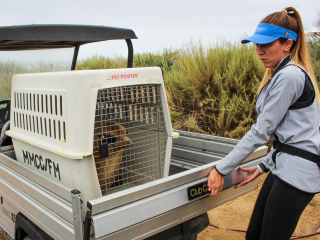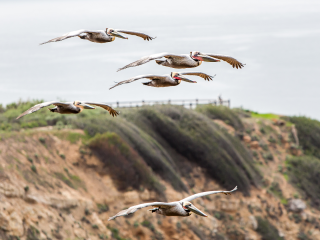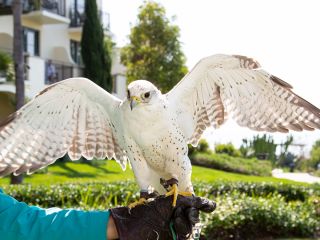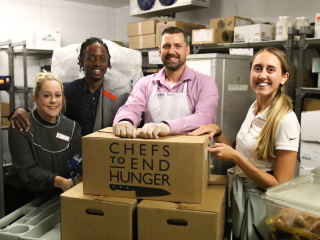Nature Haven
Rolling hillsides of coastal native plants. A crisp view of Catalina Island in the distance. Breaching gray whales.
However vibrant the grand estates dotting the hillsides, however perfect the vistas that rival any Italian riviera, this land is still, seemingly impossibly, unspoiled by humans.
But that’s not by chance; it’s by design. By air, by sea, by land, Terranea’s untouched setting in the Southern California sun captures the hearts of its visitors, thanks to the chance of history and the stewardship of its owners to craft an eco-friendly home for all of its visitors.
Once a part of the Channel Islands, the Palos Verdes Peninsula shifted over millions of years to join the California coast. While the indigenous Gabrielino-Tongva Tribe had long fared well as seafarers, traders, and fishermen, the area’s Spanish name, Cañada de Palos Verdes (“canyon of green trees”) hints at the verdant treasure that explorer Juan Cabrillo set foot on in 1542. The Rancho de los Palos Verdes Mexican land grant of 1846 to Jose Loreto and Juan Capistrano Sepulveda ushered in the era of horse and buggy. In the early 1900s, Japanese farming communities harvested the agricultural bounty of the hillsides, from olives to prickly pears. Inspired by the rivieras of the Mediterranean, the founding father of the Palos Verdes Peninsula, Frank A. Vanderlip, and a consortium of New York investors, purchased 16,000 acres of beauty, sight unseen, in 1913. Their vision? A year-round colony for the well-to-do.
The postcard-perfect landscape attracted California’s first major theme park, Marineland of the Pacific, which opened in 1954, a year before Disneyland. When Marineland of the Pacific shuttered in 1986—acquired by competitor SeaWorld—years of planning elapsed before Lowe Enterprises took on an eco-logically sensitive development, in 1998. Nothing was thrown away of the seaside park and sanctuary; even 45 of Marine-land’s original coral trees were salvaged and replanted around the grounds.
From the oil paintings from the Portuguese Bend Art Colony to the minty coastal sage perfuming the air, the result is a finely crafted homage to the peninsula that also honors classic Medi-terranean and Mission architecture.
Today, Terranea harmonizes with its surroundings, as a seemingly timeless grand estate on the hill. The coastal bluff trails are a wildlife wonderland, teeming with the peninsula’s three species of hummingbirds, playing among the colorful birds of paradise. The ocean is cleaner than ever, thanks to complex filtration systems and dedicated Green Team kayak cleanups. The shimmering, undulating expanse of cobalt—which is also a marine-protected area—is often punctuated by leaping dolphins and gray whales. It’s the California you were meant to experience.

Treading Lightly
Terranea Sustainability Leader Lauren Bergloff discusses how connecting to the land is the first way to practice sustainability.
What does it mean that Terranea is the only “non-preserve” area in the surroundings?
From the shores to three miles out to sea is a marine-protected, “no-take” area. On the other side, it’s Palos Verdes Nature Preserve, and you can hike from the lighthouse all the way through to the edge of it, where the golf course is. We’re surrounded by nature. There is a marine protected “no-take” area from the shores of our property to three miles out to sea. On the opposite side of the resort, is the Palos Verdes Nature Preserve. You can hike from the lighthouse all the way through to the edge of it, where the golf course is. We are surrounded by nature preserve.
Seventy-five percent of the property is now green space, and there’s 14 acres of restored habitat. But, When it was Marineland, it was basically all concrete and asphalt. So, when it rained, everything just rushed into the ocean from the hills. Now, the rain is able to go into the groundwater, seep into it, and if there’s any-thing else leftover, it’s filtered through seven different vaults. We’re this little pocket that was developed in a way that is better for the environment when it rains.
What do you mean by vaults?
They’re called contact Contech storm drain systems. It’s basically a huge room below us. They add the filters so that any fertilizers, pesticides, oils and other runoff that gets collected is filtered out. Twice per year it is vacuumed out with huge trucks.
How has it felt to watch this evolve over the last decade?
Can you imagine building this place from the ground up? It’s a vast swath of land, 102 acres. It was all covered in concrete. Instead of throwing away or hauling off all the concrete, they broke it up and used it underneath the roadways. Marineland was pretty flat; now, Terranea is terraced with spectacular views. All the plants were seedlings from the peninsula itself, so you get to see what happens when you allow those native plants to grow full.
How would you describe the relationship between the flora and fauna here?
Mutualistic symbiotic is when they both benefit; we have a lot of that here. Some guests from Manhattan Beach, which is close by, were on my Guided Coastal Walk recently. They said, “Why do you have so many birds?” I said, “Because they have the space to live! They have their habitat.”
I studied Environmental Science in school, and I feel it was a lot of doom and gloom. That’s why I love this story. I would have never thought a development could be beneficial for the environment, but it is possible if it is done right. Here we have the coastal buckwheat plant. And here’s a little butterfly, as big as my thumb: the El Segundo blue butterfly. They are endangered. They need that plant to survive. So The places that we’ve seen them come back are here and El Segundo. Chevron did a plant restoration project right by LAX. So The fact that we developed, the fact that animals are coming back and making Terranea their home, it’s so special. The rabbits you see around the property—they weren’t placed here; they came back. These butterflies, all of the birds, hummingbirds, red-tailed hawks, ospreys, egrets. You know that saying, “if you build it, they will come?” It’s true!
How do you encourage guests to open their eyes and be conscious about reducing waste?
I encourage guests to carve some time for one of the resort’s self-guided nature walks. By walking around with a mindful eye, guests can really see how much went into the development here. Todd Majcher, Senior Vice President of Resort Development and Design for Lowe, talks about Sincere Development rather than Sustainable Development, which I think is such an interesting way to put it. He thinks that sustainability is kind of a buzzword. If you’re being sincere and thinking about the land that you’re on and giving it respect, you’re going to be sustainable. Our ocean water is now cleaner than it was before, because of the measures put in place during development.
The choices you make as a guest are then informed by that sincerity?
When you’re traveling, you might be inspired to ask for a “for-here” cup or bring your own water bottle. I always tell people it takes 21 days to break a habit. And you just have to be willing to work through it. It’s not always going be perfect.
Whether you take a meditative walk, jog, bicycle, or take the dog out for fresh air, the treasure chest of well-preserved hiking trails traversing the peninsula are open to the public. Two miles of coastal trails are right on Terranea’s coastal-sage-perfumed grounds. For those curious about the history of the property and the surrounding flora and fauna, enjoy Terranea’s self-guided nature walks and pick up a map at pointe discovery.
GREEN IMPACT: On a mission to end hunger
To address the critical problem of food waste, Terranea partners with Chefs to End Hunger. Leftover food that hasn’t been served is packaged in special “Hunger Kit” boxes, picked up, and delivered to Midnight Mission in Downtown L.A. Since 2017, the resort has donated more than 19,000 21,000 pounds of food that would have been thrown away. It’s all in support of the resort’s pledge to reduce energy and water usage.
● Purchase, bring, or ask for a ceramic mug when planning to sit at a coffee shop.
● Bring your own refillable amenities, or open only what you need.
● Use your own, refillable water bottle instead of single-use plastic water bottles.
● Don’t forget your reusable shopping bags.
● Travel as locally as possible to reduce carbon emissions.
● Buy only what you need to start your personal journey in source reduction.
GREEN IMPACT: Fresh Thinking
When preparing a room for each new guest arrival in a luxury hotel, common protocol calls for a fresh roll of toilet paper in the bathroom. But what happens to all those half rolls?
After a guest on one of Bergloff’s guided nature walks mentioned that the Midnight Mission—the very place where Terranea donates its surplus food—also picks up donations, the resort began sending usable toiletries from guest rooms to those who need them.
“What’s even better news is,” Bergloff adds, “California just passed a law that, by 2023, all hotels will have bulk dispensing units.”
Since December 2017, Terranea has donated 29,663 rolls of toilet paper (3,818 pounds) and 63,362 bottles of toiletries (5,022 pounds) to Midnight Mission.

Wild Things
A number of conservation-focused and educational activities embrace the rich wildlife habitat surrounding this unusually pristine coastal resort. View fauna, big and small, in their natural environs: from monolithic whales and frolicking rabbits to El Segundo blue butterflies.
Naturalist-led tours and trail walks guide you through the resort’s scenic walking, hiking, and bird-watching footpaths, all part of the Discovery Trail that connects with the Palos Verdes Peninsula trail system.
In this rarefied setting, blue and Pacific gray whales migrate only 50 yards offshore, and dolphins and sea lions can be spotted daily. Peer through a coin-operated telescope along one of the coastal bluffs leading down to the cove. Proceeds support nonprofit environ-mental partners such as the Palos Verdes Peninsula Land Conservancy.
On World Oceans Day and Earth Day, the resort collaborates with the Marine Mammal Care Center and International Bird Rescue to release rehabilitated pelicans and sea lions back into the wild, at the beach cove.
This Land is Your Land
The Experience Concierge is your first resource for crafting unforgettable recreational excursions. Opportunities include:

BY LAND
Take a Self-Guided Coastal Walk
Head to pointe discovery to learn about the area’s rich environmental history and the resort’s sustainability practices, and to fully absorb the beauty of this gorgeous setting.
Bike the Bluffs
Two miles of bluff trails teeming with the perfume of coastal sage are waiting for you to zoom through on one of our fleet of electric bicycles. Rent by the hour, or day, at pointe discovery.
Seaside Spinning
Jump-start your day with an al fresco spinning class on the fitness studio deck.
Hug the Coast
With the complimentary Lexus Drive Experience, travelers itching for a true California road trip can explore the peninsula’s winding byways from behind the wheel of a variety of new Lexus sedans, SUVs, and hybrids. Arrange your trip at the Experience Center, next to sea beans and marea.
Curious about a plant while on a leisurely hike? Download the iNaturalist app to learn more about what you see.

BY AIR
The Ancient Art of Falconry
You might spot the majestic wingspan of a red-tailed hawk, yet you likely won’t see (or hear) a flock of seagulls or a murder of crows. Why? Since opening, the resort has utilized falconry and birds of prey as a natural abatement. Join the resident falconer for a private meet and greet session.
Bow and Arrow
Dating back 5,000 years, archery was once used by the Tongva people who inhabited the Palos Verdes Peninsula. Now you can experience the sport on the property’s beach cove, where skilled instructors provide all of the equipment, as well as helpful instruction, followed by shooting practice and games.
Look Up
Without the light pollution of Los Angeles, stargazing here is ideal. Download astronomy apps such as SkyView to illuminate your viewing or nab a few astronomy supplies at pointe discovery.

BY SEA
Whale Watching
With shooting sprays in the distance, spot nature’s awe-inspiring, prehistoric creatures, rolling and showing their pectoral flippers! Families especially enjoy the in-depth experience of a catamaran charter with experienced captains during gray (December–May) and blue (June–September) whale migration seasons.
Tide Pooling
At low tide, hike to the rocky shoreline at water’s edge and enter mini aquariums waiting for your observation and exploration. Teeming with anemones, baby fish, and hermit crabs, tide pools provide all-ages entertainment. Guided tours by foot or by kayak are available!
Ocean Exploring
Terranea’s coastline. Joining the party, you might see bottle-nose dolphins, sea lions, seals, and the electric blue and orange of California’s marine state fish, the garibaldi.
Pool Therapy
With four ocean-view pools, each with its own distinct character, Terranea’s pools are ideal for attuning oneself with the fluidity of nature.





























